
- 阻害剤
- 研究分野別
- PI3K/Akt/mTOR
- Epigenetics
- Methylation
- Immunology & Inflammation
- Protein Tyrosine Kinase
- Angiogenesis
- Apoptosis
- Autophagy
- ER stress & UPR
- JAK/STAT
- MAPK
- Cytoskeletal Signaling
- Cell Cycle
- TGF-beta/Smad
- 化合物ライブラリー
- Popular Compound Libraries
- Customize Library
- Clinical and FDA-approved Related
- Bioactive Compound Libraries
- Inhibitor Related
- Natural Product Related
- Metabolism Related
- Cell Death Related
- By Signaling Pathway
- By Disease
- Anti-infection and Antiviral Related
- Neuronal and Immunology Related
- Fragment and Covalent Related
- FDA-approved Drug Library
- FDA-approved & Passed Phase I Drug Library
- Preclinical/Clinical Compound Library
- Bioactive Compound Library-I
- Bioactive Compound Library-II
- Kinase Inhibitor Library
- Express-Pick Library
- Natural Product Library
- Human Endogenous Metabolite Compound Library
- Alkaloid Compound LibraryNew
- Angiogenesis Related compound Library
- Anti-Aging Compound Library
- Anti-alzheimer Disease Compound Library
- Antibiotics compound Library
- Anti-cancer Compound Library
- Anti-cancer Compound Library-Ⅱ
- Anti-cancer Metabolism Compound Library
- Anti-Cardiovascular Disease Compound Library
- Anti-diabetic Compound Library
- Anti-infection Compound Library
- Antioxidant Compound Library
- Anti-parasitic Compound Library
- Antiviral Compound Library
- Apoptosis Compound Library
- Autophagy Compound Library
- Calcium Channel Blocker LibraryNew
- Cambridge Cancer Compound Library
- Carbohydrate Metabolism Compound LibraryNew
- Cell Cycle compound library
- CNS-Penetrant Compound Library
- Covalent Inhibitor Library
- Cytokine Inhibitor LibraryNew
- Cytoskeletal Signaling Pathway Compound Library
- DNA Damage/DNA Repair compound Library
- Drug-like Compound Library
- Endoplasmic Reticulum Stress Compound Library
- Epigenetics Compound Library
- Exosome Secretion Related Compound LibraryNew
- FDA-approved Anticancer Drug LibraryNew
- Ferroptosis Compound Library
- Flavonoid Compound Library
- Fragment Library
- Glutamine Metabolism Compound Library
- Glycolysis Compound Library
- GPCR Compound Library
- Gut Microbial Metabolite Library
- HIF-1 Signaling Pathway Compound Library
- Highly Selective Inhibitor Library
- Histone modification compound library
- HTS Library for Drug Discovery
- Human Hormone Related Compound LibraryNew
- Human Transcription Factor Compound LibraryNew
- Immunology/Inflammation Compound Library
- Inhibitor Library
- Ion Channel Ligand Library
- JAK/STAT compound library
- Lipid Metabolism Compound LibraryNew
- Macrocyclic Compound Library
- MAPK Inhibitor Library
- Medicine Food Homology Compound Library
- Metabolism Compound Library
- Methylation Compound Library
- Mouse Metabolite Compound LibraryNew
- Natural Organic Compound Library
- Neuronal Signaling Compound Library
- NF-κB Signaling Compound Library
- Nucleoside Analogue Library
- Obesity Compound Library
- Oxidative Stress Compound LibraryNew
- Phenotypic Screening Library
- PI3K/Akt Inhibitor Library
- Protease Inhibitor Library
- Protein-protein Interaction Inhibitor Library
- Pyroptosis Compound Library
- Small Molecule Immuno-Oncology Compound Library
- Mitochondria-Targeted Compound LibraryNew
- Stem Cell Differentiation Compound LibraryNew
- Stem Cell Signaling Compound Library
- Natural Phenol Compound LibraryNew
- Natural Terpenoid Compound LibraryNew
- TGF-beta/Smad compound library
- Traditional Chinese Medicine Library
- Tyrosine Kinase Inhibitor Library
- Ubiquitination Compound Library
-
Cherry Picking
You can personalize your library with chemicals from within Selleck's inventory. Build the right library for your research endeavors by choosing from compounds in all of our available libraries.
Please contact us at info@selleck.co.jp to customize your library.
You could select:
- 抗体
- 新製品
- お問い合わせ
c-Kit
c-Kit製品
- All (52)
- c-Kit阻害剤 (52)
- 新製品
| 製品コード | 製品名称 | 製品説明 | 文献中Selleckの製品使用例 | お客様のフィードバック |
|---|---|---|---|---|
| S1021 | Dasatinib | Dasatinibは新規の強力なマルチターゲット阻害剤であり、cell-free assy における Abl, Src および c-Kit に対する IC50 はそれぞれ < 1 nM, 0.8 nM および 79 nM です。Dsatinib はオートファジー (autophagy) とアポトーシス (apoptosis) を誘発し、抗腫瘍活性を示します。 |
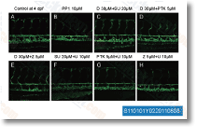
|
|
| S2475 | Imatinib | Imatinib is a multi-target inhibitor of tyrosine kinase with inhibition for v-Abl, c-Kit and PDGFR, IC50 values are 0.6 μM, 0.1 μM and 0.1 μM in cell-free or cell-based assays, respectively. Imatinib (STI571) induces autophagy. |
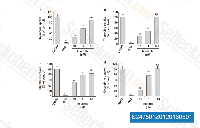
|
|
| S1040 | Sorafenib tosylate | Sorafenib tosylate is a multikinase inhibitor of Raf-1 and B-Raf with IC50 of 6 nM and 22 nM in cell-free assays, respectively. Sorafenib Tosylate inhibits VEGFR-2, VEGFR-3, PDGFR-β, Flt-3 and c-KIT with IC50 of 90 nM, 20 nM, 57 nM, 59 nM and 68 nM, respectively. Sorafenib Tosylate induces autophagy and apoptosis and activates ferroptosis with anti-tumor activity. |
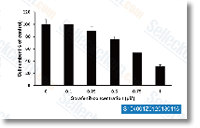
|
|
| S7782 | Dasatinib Monohydrate | Dasatinib Monohydrate (BMS-354825) is a novel, potent and multi-targeted inhibitor that targets Abl, Src and c-Kit, with IC50 of <1 nM, 0.8 nM and 79 nM, respectively. |

|
|
| S1026 | Imatinib (STI571) Mesylate | Imatinib Mesylate is an orally bioavailability mesylate salt of Imatinib, which is a multi-target inhibitor of v-Abl, c-Kit and PDGFR with IC50 of 0.6 μM, 0.1 μM and 0.1 μM in cell-free or cell-based assays, respectively. Imatinib Mesylate (STI571) induces autophagy. |
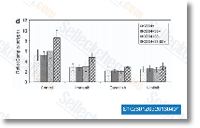
|
|
| S7781 | Sunitinib (SU-11248) | Sunitinib is a multi-targeted RTK inhibitor targeting VEGFR2 (Flk-1) and PDGFRβ with IC50 of 80 nM and 2 nM, and also inhibits c-Kit. Sunitinib is also a dose-dependent inhibitor of the autophosphorylation activity of IRE1α. Sunitinib induces autophagy and apoptosis. |

|
|
| S1178 | Regorafenib (BAY 73-4506) | Regorafenibは VEGFR1, VEGFR2, VEGFR3, PDGFRβ, Kit (c-Kit), RET (c-RET) および Raf-1 に対するマルチターゲット阻害剤であり、cell-free assay における IC50 はそれぞれ 13 nM/4.2 nM/46 nM, 22 nM, 7 nM, 1.5 nM, 2.5 nM です。Regorafenib はオートファジーを誘導します。 |
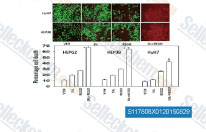
|
|
| S1005 | Axitinib (AG-013736) | Axitinib is a multi-target inhibitor of VEGFR1, VEGFR2, VEGFR3, PDGFRβ and c-Kit with IC50 of 0.1 nM, 0.2 nM, 0.1-0.3 nM, 1.6 nM and 1.7 nM in Porcine aorta endothelial cells, respectively. |
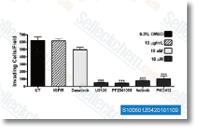
|
|
| S1042 | Sunitinib malate | Sunitinib malate is a multi-targeted RTK inhibitor targeting VEGFR2 (Flk-1) and PDGFRβ with IC50 of 80 nM and 2 nM in cell-free assays, and also inhibits c-Kit. Sunitinib Malate effectively inhibits autophosphorylation of Ire1α. Sunitinib Malate increases both death receptor and mitochondrial-dependent apoptosis. |
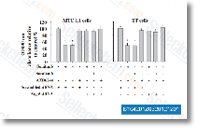
|
|
| S1164 | Lenvatinib (E7080) | レンバチニブ (Lenvatinib (E7080)) はマルチターゲット阻害剤の一種であり、主に VEGFR2(KDR)/VEGFR3(Flt-4) に対して活性を示し IC50 は 4 nM/5.2 nMである一方、VEGFR1/Flt-1に対しては活性が弱く、cell-free assay において FGFR1, PDGFRα/βよりも VEGFR2/3 に対して 10 倍高い選択性を示します。レンバチニブ (E7080) はまた FGFR1-4, PDGFR, Kit (c-Kit), RET (c-RET) も阻害し、強力な抗腫瘍活性を呈します。 |
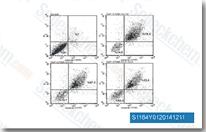
|
|
| S4001 | Cabozantinib malate | Cabozantinib malate (XL184) is the malate of Cabozantinib, a potent VEGFR2 inhibitor with IC50 of 0.035 nM and also inhibits c-Met, Ret (c-Ret), Kit (c-Kit), Flt-1/3/4, Tie2, and AXL with IC50 of 1.3 nM, 4 nM, 4.6 nM, 12 nM/11.3 nM/6 nM, 14.3 nM and 7 nM in cell-free assays, respectively. Cabozantinib malate (XL184) induces apoptosis. |
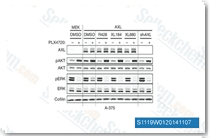
|
|
| S7818 | Pexidartinib (PLX3397) | Pexidartinib (PLX3397) is an oral, potent multi-targeted receptor tyrosine kinase inhibitor of CSF-1R, Kit (c-Kit), and FLT3 with IC50 of 20 nM, 10 nM and 160 nM, respectively. Pexidartinib (PLX3397) induces apoptosis and necrosis with antitumor activity. Phase 3. |
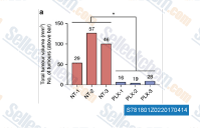
|
|
| S1111 | Foretinib | Foretinib is an ATP-competitive inhibitor of HGFR and VEGFR, mostly for Met (c-Met) and KDR with IC50 of 0.4 nM and 0.9 nM in cell-free assays. Less potent against Ron, Flt-1/3/4, Kit (c-Kit), PDGFRα/β and Tie-2, and little activity to FGFR1 and EGFR. Phase 2. |
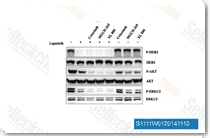
|
|
| S3012 | Pazopanib | Pazopanib (GW786034) is a novel multi-target inhibitor of VEGFR1, VEGFR2, VEGFR3, PDGFR, FGFR, c-Kit and c-Fms/CSF1R with IC50 of 10 nM, 30 nM, 47 nM, 84 nM, 74 nM, 140 nM and 146 nM in cell-free assays, respectively. Pazopanib induces cathepsin B activation and autophagy. |
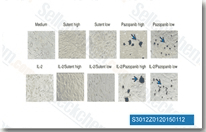
|
|
| S1017 | Cediranib (AZD2171) | Cediranib (AZD2171, NSC-732208) is a highly potent VEGFR(KDR) inhibitor with IC50 of <1 nM, also inhibits Flt1/4 with IC50 of 5 nM/≤3 nM, similar activity against c-Kit and PDGFRβ, 36-, 110-fold and >1000-fold selective more for VEGFR than PDGFR-α, CSF-1R and Flt3 in HUVEC cells. Cediranib (AZD2171) induces autophagic vacuole accumulation. Phase 3. |
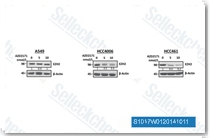
|
|
| S1035 | Pazopanib HCl | Pazopanib HCl is a novel multi-target inhibitor of VEGFR1, VEGFR2, VEGFR3, PDGFR, FGFR, c-Kit and c-Fms with IC50 of 10 nM, 30 nM, 47 nM, 84 nM, 74 nM, 140 nM and 146 nM in cell-free assays, respectively. Pazopanib induces autophagic Type II cell death. |
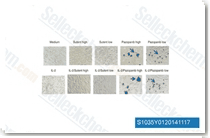
|
|
| S1018 | Dovitinib (TKI-258) | Dovitinib (TKI258, CHIR258) is a multitargeted RTK inhibitor, mostly for class III (FLT3/c-Kit) with IC50 of 1 nM/2 nM, also potent to class IV (FGFR1/3) and class V (VEGFR1-4) RTKs with IC50 of 8-13 nM, less potent to InsR, EGFR, c-Met, EphA2, Tie2, IGF-1R and HER2 in cell-free assays. Phase 4. |
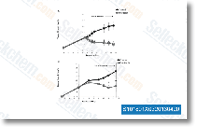
|
|
| S5077 | Regorafenib (BAY-734506) Monohydrate | Regorafenib (BAY-734506, Fluoro-sorafenib, Resihance, Stivarga) Monohydrate is a novel oral multikinase inhibitor with IC50 values of 13, 4.2, 46, 22, 7, 1.5, 2.5, 28, 19 nM for VEGFR1, murine VEGFR2, murine VEGFR3, PDGFR-β, Kit (c-Kit), RET (c-RET), RAF-1, B-RAF and B-RAF(V600E) respectively. | ||
| S1064 | Masitinib | Masitinib is a novel inhibitor for Kit (c-Kit) and PDGFRα/β with IC50 of 200 nM and 540 nM/800 nM, weak inhibition to ABL and c-Fms. Phase 3. |
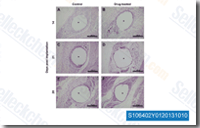
|
|
| S1207 | Tivozanib | Tivozanib is a potent and selective VEGFR inhibitor for VEGFR1/2/3 with IC50 of 30 nM/6.5 nM/15 nM, and also inhibits PDGFR and c-Kit, low activity observed against FGFR-1, Flt3, c-Met, EGFR and IGF-1R. Phase 3. |
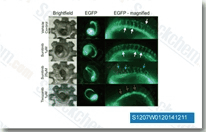
|
|
| S8401 | Erdafitinib (JNJ-42756493) | Erdafitinib is a potent and selective orally bioavailable, pan fibroblast growth factor receptor (FGFR) inhibitor with potential antineoplastic activity. Erdafitinib also binds to RET (c-RET), CSF-1R, PDGFR-α/PDGFR-β, FLT4, Kit (c-Kit) and VEGFR-2 and induces cellular apoptosis. |
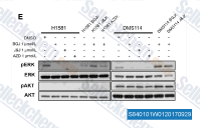
|
|
| S7765 | Dovitinib (TKI258) Lactate monohydrate | Dovitinib (TKI258) Lactate monohydrate is the Lactate of Dovitinib, which is a multitargeted RTK inhibitor, mostly for class III (FLT3/c-Kit) with IC50 of 1 nM/2 nM, also potent to class IV (FGFR1/3) and class V (VEGFR1-4) RTKs with IC50 of 8-13 nM, less potent to InsR, EGFR, c-Met, EphA2, Tie2, IGFR1 and HER2. Phase 4. |
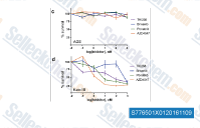
|
|
| S5240 | Lenvatinib Mesylate | Lenvatinib Mesylate is a synthetic, orally available tyrosine kinase inhibitor that inhibits vascular endothelial growth factor receptor (VEGFR1-3), fibroblast growth factor receptor (FGFR1-4), platelet-derived growth factor receptor α (PDGFRα), stem cell factor receptor (Kit (c-Kit)), and rearranged during transfection (RET (c-RET)). Lenvatinib Mesylate has potential antineoplastic activity. | ||
| S5248 | Apatinib | Apatinib (Rivoceranib, YN968D1) is a potent inhibitor of the VEGF signaling pathway with IC50 values of 1 nM, 13 nM, 429 nM and 530 nM for VEGFR-2, Ret (c-Ret), c-Kit and c-Src, respectively. Apatinib induces both autophagy and apoptosis. | ||
| S4947 | Regorafenib Hydrochloride | Regorafenib (Stivarga, BAY 73-4506) Hydrochloride is a multi-target inhibitor for VEGFR1, Murine VEGFR2/3, PDGFRβ, Kit (c-Kit), RET (c-RET) and Raf-1 with IC50 of 13 nM, 4.2 nM/46 nM, 22 nM, 7 nM, 1.5 nM and 2.5 nM, respectively. | ||
| S1363 | Ki8751 | Ki8751 is a potent and selective inhibitor of VEGFR2 with IC50 of 0.9 nM, >40-fold selective for VEGFR2 than c-Kit, PDGFRα and FGFR-2, little activity to EGFR, HGFR and InsR. |
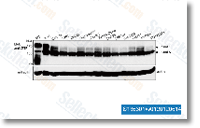
|
|
| S1244 | Amuvatinib (MP-470) | Amuvatinib (MP-470, HPK 56) is a potent and multi-targeted inhibitor of c-Kit, PDGFRα and Flt3 with IC50 of 10 nM, 40 nM and 81 nM, respectively. Amuvatinib suppresses c-MET and c-RET. Amuvatinib is also active as a DNA repair protein Rad51 inhibitor with antineoplastic activity. Phase 2. |
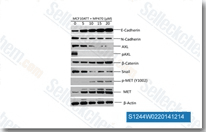
|
|
| S8024 | Tyrphostin AG 1296 | Tyrphostin AG 1296 is an inhibitor of PDGFR with IC50 of 0.3-0.5 μM, no activity to EGFR. Tyrphostin AG1296 inhibits FGFR and c-Kit with IC50 of 12.3 μM and 1.8 μM in Swiss 3T3 cells. Tyrphostin AG1296 induces dramatic apoptosis in A375R cells. |
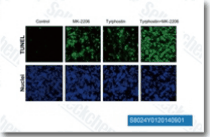
|
|
| S1032 | Motesanib Diphosphate (AMG-706) | Motesanib Diphosphate (AMG-706) is a potent ATP-competitive inhibitor of VEGFR1/2/3 with IC50 of 2 nM/3 nM/6 nM, respectively; similar activity against Kit (c-Kit), ~10-fold more selective for VEGFR than PDGFR and Ret. Phase 3. |
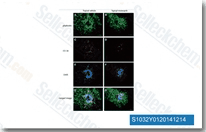
|
|
| S8553 | Avapritinib (BLU-285) | Avapritinib is a small molecule kinase inhibitor that potently inhibits PDGFRα D842V mutant activity in vitro (IC50 = 0.5 nM) and PDGFRα D842V autophosphorylation in the cellular setting (IC50 = 30 nM); also a potent inhibitor of the analogous Kit (c-Kit) mutation, D816V in Kit (c-Kit) Exon 17 (IC50 = 0.5 nM). | ||
| S1220 | OSI-930 | OSI-930 is a potent inhibitor of Kit (c-Kit), KDR and CSF-1R with IC50 of 80 nM, 9 nM and 15 nM, respectively; also potent to Flt-1, c-Raf and Lck and low activity against PDGFRα/β, Flt-3 and Abl. Phase 1. |
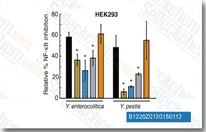
|
|
| S8757 | Ripretinib | Ripretinib is an orally bioavailable switch pocket control inhibitor of wild-type and mutated forms of the tumor-associated antigens (TAA) mast/stem cell factor receptor (SCFR) Kit (c-Kit) and PDGFR-alpha, with IC50 values of 4 nM, 8 nM, 18 nM, 5 nM and 14 nM for WT Kit (c-Kit), V654A Kit (c-Kit), T670I Kit (c-Kit), D816H Kit (c-Kit) and D816V Kit (c-Kit), respectively. | ||
| S8015 | Agerafenib (CEP-32496) | Agerafenib (CEP-32496) is a highly potent inhibitor of BRAF(V600E/WT) and c-Raf with Kd of 14 nM/36 nM and 39 nM, also potent to Abl-1, c-Kit, Ret (c-Ret), PDGFRβ and VEGFR2, respectively; insignificant affinity for MEK-1, MEK-2, ERK-1 and ERK-2. Phase 1/2. | ||
| S9662 | UNC2025 | UNC2025 is a potent and orally active dual inhibitor of FLT3 and MER with IC50 of 0.35 nM and 0.46 nM, respectively. UNC2025 also inhibits AXL, TRKA, TRKC, QIK, TYRO3, SLK, NuaK1, Kit (c-Kit) and Met (c-Met) with IC50 of 1.65 nM, 1.67 nM, 4.38 nM, 5.75 nM, 5.83 nM, 6.14 nM, 7.97 nM, 8.18 nM and 364 nM, respectively. | ||
| S2231 | Telatinib | Telatinib (BAY 57-9352) is a potent inhibitor of VEGFR2/3, c-Kit and PDGFRα with IC50 of 6 nM/4 nM, 1 nM and 15 nM, respectively. Phase 2. |
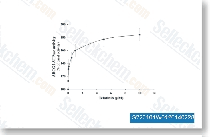
|
|
| S6662 | AST-487 (NVP-AST487) | AST-487 (NVP-AST487), a N,N'-diphenyl urea,is an ATP competitive inhibitor of Flt3 with ki of 0.12 μM.Besides FLT3, AST487 also inhibits RET,KDR,c-KIT,and c-ABL kinase with IC50 values below 1 μM. | ||
| S8573 | Sitravatinib (MGCD516) | Sitravatinib (MGCD516, MG-516) is a novel small molecule inhibitor targeting multiple RTKs involved in driving sarcoma cell growth, including c-Kit, PDGFRβ, PDGFRα, c-Met, and Axl. | ||
| S2070 | ISCK03 | ISCK03 (N-(4-imidazol-1-yl phenyl)sulfonamide) is a cell-permeable inhibitor of stem-cell factor (SCF)/c-kit signaling. ISCK03 inhibits SCF-induced c-c-kit phosphorylation and downstream ERK phosphorylation. | ||
| S7003 | AZD2932 | AZD2932 is a potent and mutil-targeted protein tyrosine kinase inhibitor with IC50 of 8 nM, 4 nM, 7 nM, and 9 nM for VEGFR-2, PDGFRβ, Flt-3, and c-Kit, respectively. | ||
| S0504 | SU14813 | SU14813 (SU 014813) is a multiple receptor tyrosine kinase inhibitor with IC50 of 50 nM, 2 nM, 4 nM and 15 nM for VEGFR2, VEGFR1, PDGFRβ and Kit (c-Kit). SU14813 exhibits potent antiangiogenic and antitumor activity. | ||
| S8721 | PDGFR inhibitor 1 | PDGFR inhibitor 1 is an orally bioavailable switch pocket control inhibitor of wild-type and mutated forms of Kit (c-Kit) and PDGFR with potential antineoplastic activity. It also inhibits several other kinases, including VEGFR2, TIE2, PDGFR-beta and CSF1R, thereby further inhibiting tumor cell growth. | ||
| S0278 | SU5614 | SU5614 (Chloro-SU5416, Chloro-Semaxanib) is a small molecule receptor tyrosine kinases (RTK) inhibitor of VEGFR-2, c-kit, and both wild-type and mutant FLT3. SU5614 reduces cell proliferation and induces apoptosis. | ||
| E2629 | Vimseltinib | Vimseltinib (DCC-3014) is a c-FMS (CSF-IR) and c-Kit dual inhibitor extracted from patent WO2014145025A2, Compound Example 10, has IC50s of <0.01 μM and 0.1-1 μM, respectively. | ||
| S7688 | Ki20227 | Ki20227 is an orally active and highly selective inhibitor of c-Fms tyrosine kinase(CSF1R) with IC50 of 2 nM, 12 nM, 451 nM and 217 nM for c-Fms, vascular endothelial growth factor receptor-2 (KDR/VEGFR-2), stem cell factor receptor (c-Kit), and platelet-derived growth factor receptor beta (PDGFRβ), respectively. | ||
| E1662 | Elenestinib phosphate | Elenestinib phosphate(BLU-263 phosphate) is a potent and orally active inhibitor of tyrosine kinase that exhibits potent inhibition of c-KIT (D816V) mutation. BLU-263 phosphate has the potential for its use in the research of systemic mastocytosis (SM). | ||
| S9881 | M4205(IDRX-42) | M4205 (IDRX-42) is an oral, selective inhibitor of KIT with broad activity against mutations in KIT exons 11, 13, and 17. It exhibits significant and dose-dependent antitumor activity in the xenograft model of GIST. | ||
| E0616 | Chiauranib | Chiauranib (CS2164) selectively inhibits multiple kinase targets aurora B kinase (AURKB), colony-stimulating factor 1 receptor (CSF1R), and vascular endothelial growth factor receptor (VEGFR)/platelet-derived growth factor receptor (PDGFR)/c-Kit , thereby inhibiting the rapid proliferation of tumor cells, enhancing the antitumor immunity, and inhibiting tumor angiogenesis, to achieve the anti-tumor efficacy. | ||
| S0377 | CS-2660 (JNJ-38158471) | CS-2660 (JNJ-38158471) 是一种耐受性良好的、口服有效的、高选择性的 VEGFR-2 抑制剂,IC50值为40 nM。CS-2660(JNJ-38158471)还抑制紧密相关的酪氨酸激酶,如 RET (c-RET) 和 Kit (c-Kit),IC50为180 nM和500 nM,但无明显活性 (>1 microM) 针对VEGFR-1和VEGFR-3。 | ||
| E0814 | Masitinib mesylate | Masitinib mesylate (AB-1010 mesylate) is a potent, orally bioavailable, and selective inhibitor of c-Kit with IC50 of 200 nM for human recombinant c-Kit, also inhibits PDGFRα/β with IC50s of 540/800 nM, Lyn with IC50 of 510 nM for LynB, and, to a lesser extent, FGFR3 and FAK. | ||
| S8780 | AZD3229 | AZD3229 is a potent, pan-Kit (c-Kit) mutant inhibitor with potent single digit nM growth inhibition against a diverse panel of mutant Kit (c-Kit) driven Ba/F3 cell lines (GI50=1-50 nM), with good margin to KDR-driven effects. It also inhibits PDGFR mutants (Tel-PDGFRα, Tel-PDGFRβ, V561D/D842V). | ||
| E1509 | Bezuclastinib | Bezuclastinib(CGT9486; PLX 9486) is a potent inhibitor of c-kit and c-kit D816V with an IC50 value of <1 μM. Bezuclastinib is also an inhibitor of tyrosine kinase. | ||
| S9973 | Flumatinib (HH-GV-678) | Flumatinib (HH-GV-678) is a novel inhibitor of Bcr-Abl with IC50 values of 1.2 nM, 307.6 nM and 665.5 nM for c-Abl, PDGFRβand c-Kit, respectively. | ||
| S1021 | Dasatinib | Dasatinibは新規の強力なマルチターゲット阻害剤であり、cell-free assy における Abl, Src および c-Kit に対する IC50 はそれぞれ < 1 nM, 0.8 nM および 79 nM です。Dsatinib はオートファジー (autophagy) とアポトーシス (apoptosis) を誘発し、抗腫瘍活性を示します。 |

|
|
| S2475 | Imatinib | Imatinib is a multi-target inhibitor of tyrosine kinase with inhibition for v-Abl, c-Kit and PDGFR, IC50 values are 0.6 μM, 0.1 μM and 0.1 μM in cell-free or cell-based assays, respectively. Imatinib (STI571) induces autophagy. |

|
|
| S1040 | Sorafenib tosylate | Sorafenib tosylate is a multikinase inhibitor of Raf-1 and B-Raf with IC50 of 6 nM and 22 nM in cell-free assays, respectively. Sorafenib Tosylate inhibits VEGFR-2, VEGFR-3, PDGFR-β, Flt-3 and c-KIT with IC50 of 90 nM, 20 nM, 57 nM, 59 nM and 68 nM, respectively. Sorafenib Tosylate induces autophagy and apoptosis and activates ferroptosis with anti-tumor activity. |

|
|
| S7782 | Dasatinib Monohydrate | Dasatinib Monohydrate (BMS-354825) is a novel, potent and multi-targeted inhibitor that targets Abl, Src and c-Kit, with IC50 of <1 nM, 0.8 nM and 79 nM, respectively. |

|
|
| S1026 | Imatinib (STI571) Mesylate | Imatinib Mesylate is an orally bioavailability mesylate salt of Imatinib, which is a multi-target inhibitor of v-Abl, c-Kit and PDGFR with IC50 of 0.6 μM, 0.1 μM and 0.1 μM in cell-free or cell-based assays, respectively. Imatinib Mesylate (STI571) induces autophagy. |

|
|
| S7781 | Sunitinib (SU-11248) | Sunitinib is a multi-targeted RTK inhibitor targeting VEGFR2 (Flk-1) and PDGFRβ with IC50 of 80 nM and 2 nM, and also inhibits c-Kit. Sunitinib is also a dose-dependent inhibitor of the autophosphorylation activity of IRE1α. Sunitinib induces autophagy and apoptosis. |

|
|
| S1178 | Regorafenib (BAY 73-4506) | Regorafenibは VEGFR1, VEGFR2, VEGFR3, PDGFRβ, Kit (c-Kit), RET (c-RET) および Raf-1 に対するマルチターゲット阻害剤であり、cell-free assay における IC50 はそれぞれ 13 nM/4.2 nM/46 nM, 22 nM, 7 nM, 1.5 nM, 2.5 nM です。Regorafenib はオートファジーを誘導します。 |

|
|
| S1005 | Axitinib (AG-013736) | Axitinib is a multi-target inhibitor of VEGFR1, VEGFR2, VEGFR3, PDGFRβ and c-Kit with IC50 of 0.1 nM, 0.2 nM, 0.1-0.3 nM, 1.6 nM and 1.7 nM in Porcine aorta endothelial cells, respectively. |

|
|
| S1042 | Sunitinib malate | Sunitinib malate is a multi-targeted RTK inhibitor targeting VEGFR2 (Flk-1) and PDGFRβ with IC50 of 80 nM and 2 nM in cell-free assays, and also inhibits c-Kit. Sunitinib Malate effectively inhibits autophosphorylation of Ire1α. Sunitinib Malate increases both death receptor and mitochondrial-dependent apoptosis. |

|
|
| S1164 | Lenvatinib (E7080) | レンバチニブ (Lenvatinib (E7080)) はマルチターゲット阻害剤の一種であり、主に VEGFR2(KDR)/VEGFR3(Flt-4) に対して活性を示し IC50 は 4 nM/5.2 nMである一方、VEGFR1/Flt-1に対しては活性が弱く、cell-free assay において FGFR1, PDGFRα/βよりも VEGFR2/3 に対して 10 倍高い選択性を示します。レンバチニブ (E7080) はまた FGFR1-4, PDGFR, Kit (c-Kit), RET (c-RET) も阻害し、強力な抗腫瘍活性を呈します。 |

|
|
| S4001 | Cabozantinib malate | Cabozantinib malate (XL184) is the malate of Cabozantinib, a potent VEGFR2 inhibitor with IC50 of 0.035 nM and also inhibits c-Met, Ret (c-Ret), Kit (c-Kit), Flt-1/3/4, Tie2, and AXL with IC50 of 1.3 nM, 4 nM, 4.6 nM, 12 nM/11.3 nM/6 nM, 14.3 nM and 7 nM in cell-free assays, respectively. Cabozantinib malate (XL184) induces apoptosis. |

|
|
| S7818 | Pexidartinib (PLX3397) | Pexidartinib (PLX3397) is an oral, potent multi-targeted receptor tyrosine kinase inhibitor of CSF-1R, Kit (c-Kit), and FLT3 with IC50 of 20 nM, 10 nM and 160 nM, respectively. Pexidartinib (PLX3397) induces apoptosis and necrosis with antitumor activity. Phase 3. |

|
|
| S1111 | Foretinib | Foretinib is an ATP-competitive inhibitor of HGFR and VEGFR, mostly for Met (c-Met) and KDR with IC50 of 0.4 nM and 0.9 nM in cell-free assays. Less potent against Ron, Flt-1/3/4, Kit (c-Kit), PDGFRα/β and Tie-2, and little activity to FGFR1 and EGFR. Phase 2. |

|
|
| S3012 | Pazopanib | Pazopanib (GW786034) is a novel multi-target inhibitor of VEGFR1, VEGFR2, VEGFR3, PDGFR, FGFR, c-Kit and c-Fms/CSF1R with IC50 of 10 nM, 30 nM, 47 nM, 84 nM, 74 nM, 140 nM and 146 nM in cell-free assays, respectively. Pazopanib induces cathepsin B activation and autophagy. |

|
|
| S1017 | Cediranib (AZD2171) | Cediranib (AZD2171, NSC-732208) is a highly potent VEGFR(KDR) inhibitor with IC50 of <1 nM, also inhibits Flt1/4 with IC50 of 5 nM/≤3 nM, similar activity against c-Kit and PDGFRβ, 36-, 110-fold and >1000-fold selective more for VEGFR than PDGFR-α, CSF-1R and Flt3 in HUVEC cells. Cediranib (AZD2171) induces autophagic vacuole accumulation. Phase 3. |

|
|
| S1035 | Pazopanib HCl | Pazopanib HCl is a novel multi-target inhibitor of VEGFR1, VEGFR2, VEGFR3, PDGFR, FGFR, c-Kit and c-Fms with IC50 of 10 nM, 30 nM, 47 nM, 84 nM, 74 nM, 140 nM and 146 nM in cell-free assays, respectively. Pazopanib induces autophagic Type II cell death. |

|
|
| S1018 | Dovitinib (TKI-258) | Dovitinib (TKI258, CHIR258) is a multitargeted RTK inhibitor, mostly for class III (FLT3/c-Kit) with IC50 of 1 nM/2 nM, also potent to class IV (FGFR1/3) and class V (VEGFR1-4) RTKs with IC50 of 8-13 nM, less potent to InsR, EGFR, c-Met, EphA2, Tie2, IGF-1R and HER2 in cell-free assays. Phase 4. |

|
|
| S5077 | Regorafenib (BAY-734506) Monohydrate | Regorafenib (BAY-734506, Fluoro-sorafenib, Resihance, Stivarga) Monohydrate is a novel oral multikinase inhibitor with IC50 values of 13, 4.2, 46, 22, 7, 1.5, 2.5, 28, 19 nM for VEGFR1, murine VEGFR2, murine VEGFR3, PDGFR-β, Kit (c-Kit), RET (c-RET), RAF-1, B-RAF and B-RAF(V600E) respectively. | ||
| S1064 | Masitinib | Masitinib is a novel inhibitor for Kit (c-Kit) and PDGFRα/β with IC50 of 200 nM and 540 nM/800 nM, weak inhibition to ABL and c-Fms. Phase 3. |

|
|
| S1207 | Tivozanib | Tivozanib is a potent and selective VEGFR inhibitor for VEGFR1/2/3 with IC50 of 30 nM/6.5 nM/15 nM, and also inhibits PDGFR and c-Kit, low activity observed against FGFR-1, Flt3, c-Met, EGFR and IGF-1R. Phase 3. |

|
|
| S8401 | Erdafitinib (JNJ-42756493) | Erdafitinib is a potent and selective orally bioavailable, pan fibroblast growth factor receptor (FGFR) inhibitor with potential antineoplastic activity. Erdafitinib also binds to RET (c-RET), CSF-1R, PDGFR-α/PDGFR-β, FLT4, Kit (c-Kit) and VEGFR-2 and induces cellular apoptosis. |

|
|
| S7765 | Dovitinib (TKI258) Lactate monohydrate | Dovitinib (TKI258) Lactate monohydrate is the Lactate of Dovitinib, which is a multitargeted RTK inhibitor, mostly for class III (FLT3/c-Kit) with IC50 of 1 nM/2 nM, also potent to class IV (FGFR1/3) and class V (VEGFR1-4) RTKs with IC50 of 8-13 nM, less potent to InsR, EGFR, c-Met, EphA2, Tie2, IGFR1 and HER2. Phase 4. |

|
|
| S5240 | Lenvatinib Mesylate | Lenvatinib Mesylate is a synthetic, orally available tyrosine kinase inhibitor that inhibits vascular endothelial growth factor receptor (VEGFR1-3), fibroblast growth factor receptor (FGFR1-4), platelet-derived growth factor receptor α (PDGFRα), stem cell factor receptor (Kit (c-Kit)), and rearranged during transfection (RET (c-RET)). Lenvatinib Mesylate has potential antineoplastic activity. | ||
| S5248 | Apatinib | Apatinib (Rivoceranib, YN968D1) is a potent inhibitor of the VEGF signaling pathway with IC50 values of 1 nM, 13 nM, 429 nM and 530 nM for VEGFR-2, Ret (c-Ret), c-Kit and c-Src, respectively. Apatinib induces both autophagy and apoptosis. | ||
| S4947 | Regorafenib Hydrochloride | Regorafenib (Stivarga, BAY 73-4506) Hydrochloride is a multi-target inhibitor for VEGFR1, Murine VEGFR2/3, PDGFRβ, Kit (c-Kit), RET (c-RET) and Raf-1 with IC50 of 13 nM, 4.2 nM/46 nM, 22 nM, 7 nM, 1.5 nM and 2.5 nM, respectively. | ||
| S1363 | Ki8751 | Ki8751 is a potent and selective inhibitor of VEGFR2 with IC50 of 0.9 nM, >40-fold selective for VEGFR2 than c-Kit, PDGFRα and FGFR-2, little activity to EGFR, HGFR and InsR. |

|
|
| S1244 | Amuvatinib (MP-470) | Amuvatinib (MP-470, HPK 56) is a potent and multi-targeted inhibitor of c-Kit, PDGFRα and Flt3 with IC50 of 10 nM, 40 nM and 81 nM, respectively. Amuvatinib suppresses c-MET and c-RET. Amuvatinib is also active as a DNA repair protein Rad51 inhibitor with antineoplastic activity. Phase 2. |

|
|
| S8024 | Tyrphostin AG 1296 | Tyrphostin AG 1296 is an inhibitor of PDGFR with IC50 of 0.3-0.5 μM, no activity to EGFR. Tyrphostin AG1296 inhibits FGFR and c-Kit with IC50 of 12.3 μM and 1.8 μM in Swiss 3T3 cells. Tyrphostin AG1296 induces dramatic apoptosis in A375R cells. |

|
|
| S1032 | Motesanib Diphosphate (AMG-706) | Motesanib Diphosphate (AMG-706) is a potent ATP-competitive inhibitor of VEGFR1/2/3 with IC50 of 2 nM/3 nM/6 nM, respectively; similar activity against Kit (c-Kit), ~10-fold more selective for VEGFR than PDGFR and Ret. Phase 3. |

|
|
| S8553 | Avapritinib (BLU-285) | Avapritinib is a small molecule kinase inhibitor that potently inhibits PDGFRα D842V mutant activity in vitro (IC50 = 0.5 nM) and PDGFRα D842V autophosphorylation in the cellular setting (IC50 = 30 nM); also a potent inhibitor of the analogous Kit (c-Kit) mutation, D816V in Kit (c-Kit) Exon 17 (IC50 = 0.5 nM). | ||
| S1220 | OSI-930 | OSI-930 is a potent inhibitor of Kit (c-Kit), KDR and CSF-1R with IC50 of 80 nM, 9 nM and 15 nM, respectively; also potent to Flt-1, c-Raf and Lck and low activity against PDGFRα/β, Flt-3 and Abl. Phase 1. |

|
|
| S8757 | Ripretinib | Ripretinib is an orally bioavailable switch pocket control inhibitor of wild-type and mutated forms of the tumor-associated antigens (TAA) mast/stem cell factor receptor (SCFR) Kit (c-Kit) and PDGFR-alpha, with IC50 values of 4 nM, 8 nM, 18 nM, 5 nM and 14 nM for WT Kit (c-Kit), V654A Kit (c-Kit), T670I Kit (c-Kit), D816H Kit (c-Kit) and D816V Kit (c-Kit), respectively. | ||
| S8015 | Agerafenib (CEP-32496) | Agerafenib (CEP-32496) is a highly potent inhibitor of BRAF(V600E/WT) and c-Raf with Kd of 14 nM/36 nM and 39 nM, also potent to Abl-1, c-Kit, Ret (c-Ret), PDGFRβ and VEGFR2, respectively; insignificant affinity for MEK-1, MEK-2, ERK-1 and ERK-2. Phase 1/2. | ||
| S9662 | UNC2025 | UNC2025 is a potent and orally active dual inhibitor of FLT3 and MER with IC50 of 0.35 nM and 0.46 nM, respectively. UNC2025 also inhibits AXL, TRKA, TRKC, QIK, TYRO3, SLK, NuaK1, Kit (c-Kit) and Met (c-Met) with IC50 of 1.65 nM, 1.67 nM, 4.38 nM, 5.75 nM, 5.83 nM, 6.14 nM, 7.97 nM, 8.18 nM and 364 nM, respectively. | ||
| S2231 | Telatinib | Telatinib (BAY 57-9352) is a potent inhibitor of VEGFR2/3, c-Kit and PDGFRα with IC50 of 6 nM/4 nM, 1 nM and 15 nM, respectively. Phase 2. |

|
|
| S6662 | AST-487 (NVP-AST487) | AST-487 (NVP-AST487), a N,N'-diphenyl urea,is an ATP competitive inhibitor of Flt3 with ki of 0.12 μM.Besides FLT3, AST487 also inhibits RET,KDR,c-KIT,and c-ABL kinase with IC50 values below 1 μM. | ||
| S8573 | Sitravatinib (MGCD516) | Sitravatinib (MGCD516, MG-516) is a novel small molecule inhibitor targeting multiple RTKs involved in driving sarcoma cell growth, including c-Kit, PDGFRβ, PDGFRα, c-Met, and Axl. | ||
| S2070 | ISCK03 | ISCK03 (N-(4-imidazol-1-yl phenyl)sulfonamide) is a cell-permeable inhibitor of stem-cell factor (SCF)/c-kit signaling. ISCK03 inhibits SCF-induced c-c-kit phosphorylation and downstream ERK phosphorylation. | ||
| S7003 | AZD2932 | AZD2932 is a potent and mutil-targeted protein tyrosine kinase inhibitor with IC50 of 8 nM, 4 nM, 7 nM, and 9 nM for VEGFR-2, PDGFRβ, Flt-3, and c-Kit, respectively. | ||
| S0504 | SU14813 | SU14813 (SU 014813) is a multiple receptor tyrosine kinase inhibitor with IC50 of 50 nM, 2 nM, 4 nM and 15 nM for VEGFR2, VEGFR1, PDGFRβ and Kit (c-Kit). SU14813 exhibits potent antiangiogenic and antitumor activity. | ||
| S8721 | PDGFR inhibitor 1 | PDGFR inhibitor 1 is an orally bioavailable switch pocket control inhibitor of wild-type and mutated forms of Kit (c-Kit) and PDGFR with potential antineoplastic activity. It also inhibits several other kinases, including VEGFR2, TIE2, PDGFR-beta and CSF1R, thereby further inhibiting tumor cell growth. | ||
| S0278 | SU5614 | SU5614 (Chloro-SU5416, Chloro-Semaxanib) is a small molecule receptor tyrosine kinases (RTK) inhibitor of VEGFR-2, c-kit, and both wild-type and mutant FLT3. SU5614 reduces cell proliferation and induces apoptosis. | ||
| E2629 | Vimseltinib | Vimseltinib (DCC-3014) is a c-FMS (CSF-IR) and c-Kit dual inhibitor extracted from patent WO2014145025A2, Compound Example 10, has IC50s of <0.01 μM and 0.1-1 μM, respectively. | ||
| S7688 | Ki20227 | Ki20227 is an orally active and highly selective inhibitor of c-Fms tyrosine kinase(CSF1R) with IC50 of 2 nM, 12 nM, 451 nM and 217 nM for c-Fms, vascular endothelial growth factor receptor-2 (KDR/VEGFR-2), stem cell factor receptor (c-Kit), and platelet-derived growth factor receptor beta (PDGFRβ), respectively. | ||
| E1662 | Elenestinib phosphate | Elenestinib phosphate(BLU-263 phosphate) is a potent and orally active inhibitor of tyrosine kinase that exhibits potent inhibition of c-KIT (D816V) mutation. BLU-263 phosphate has the potential for its use in the research of systemic mastocytosis (SM). | ||
| S9881 | M4205(IDRX-42) | M4205 (IDRX-42) is an oral, selective inhibitor of KIT with broad activity against mutations in KIT exons 11, 13, and 17. It exhibits significant and dose-dependent antitumor activity in the xenograft model of GIST. | ||
| E0616 | Chiauranib | Chiauranib (CS2164) selectively inhibits multiple kinase targets aurora B kinase (AURKB), colony-stimulating factor 1 receptor (CSF1R), and vascular endothelial growth factor receptor (VEGFR)/platelet-derived growth factor receptor (PDGFR)/c-Kit , thereby inhibiting the rapid proliferation of tumor cells, enhancing the antitumor immunity, and inhibiting tumor angiogenesis, to achieve the anti-tumor efficacy. | ||
| S0377 | CS-2660 (JNJ-38158471) | CS-2660 (JNJ-38158471) 是一种耐受性良好的、口服有效的、高选择性的 VEGFR-2 抑制剂,IC50值为40 nM。CS-2660(JNJ-38158471)还抑制紧密相关的酪氨酸激酶,如 RET (c-RET) 和 Kit (c-Kit),IC50为180 nM和500 nM,但无明显活性 (>1 microM) 针对VEGFR-1和VEGFR-3。 | ||
| E0814 | Masitinib mesylate | Masitinib mesylate (AB-1010 mesylate) is a potent, orally bioavailable, and selective inhibitor of c-Kit with IC50 of 200 nM for human recombinant c-Kit, also inhibits PDGFRα/β with IC50s of 540/800 nM, Lyn with IC50 of 510 nM for LynB, and, to a lesser extent, FGFR3 and FAK. | ||
| S8780 | AZD3229 | AZD3229 is a potent, pan-Kit (c-Kit) mutant inhibitor with potent single digit nM growth inhibition against a diverse panel of mutant Kit (c-Kit) driven Ba/F3 cell lines (GI50=1-50 nM), with good margin to KDR-driven effects. It also inhibits PDGFR mutants (Tel-PDGFRα, Tel-PDGFRβ, V561D/D842V). | ||
| E1509 | Bezuclastinib | Bezuclastinib(CGT9486; PLX 9486) is a potent inhibitor of c-kit and c-kit D816V with an IC50 value of <1 μM. Bezuclastinib is also an inhibitor of tyrosine kinase. | ||
| S9973 | Flumatinib (HH-GV-678) | Flumatinib (HH-GV-678) is a novel inhibitor of Bcr-Abl with IC50 values of 1.2 nM, 307.6 nM and 665.5 nM for c-Abl, PDGFRβand c-Kit, respectively. |
